Response to Geomorphology of Selected Massifs On the Plains of Cydonia, Mars by David Pieri
Mark J. Carlotto, Horace W. Crater, James L. Erjavec, and Stanley V. McDaniel
Society for Planetary SETI Research (SPSR)
1. General Response
We regret that Pieri does not choose to address the data concerning the Cydonia mounds raised in our paper (Crater and McDaniel, 1999). We also regret his not having referenced several peer reviewed papers relevant to the present discussion (Carlotto 1988, OLeary 1990, Carlotto and Stein 1990, DiPietro, Molenaar, and Brandenberg 1991, Carlotto 1997). Our paper on the mound distribution at Cydonia does not refer in any way to the "Face" located in the same general area. However since Pieri has brought up the "Face" in a context of ridicule and because this object has also been studied in depth by SPSR scientists, we take this opportunity to rebut his comments, following which we will discuss the geological analysis he provides.
Pieri gives the impression that the facial appearance of the object is known to be an illusion of lighting. This interpretation was long ago refuted in a peer-reviewed article in which a threedimensional model was derived and shown to produce the appearance of a face over a wide range of lighting and viewing conditions (Carlotto 1988). (We note that none of the Viking image team scientists or other critics of the Mars anomaly research have ever responded to this article in kind, that is, in a peer-reviewed journal, or elsewhere.) Furthermore, the appearance of the object as shown in the photo taken in April 1998 by Mars Global Surveyor (MGS) was accurately predicted in advance on the basis of this same 3-D model. Subsequent analyses of the recent image show numerous points of correlation between this and the earlier image, despite different lighting conditions. (Details are summarized in the next section.) Even Carl Sagan in his 1995 book The Demon-Haunted World admits There was an unfortunate dismissal of the feature by a project official as a trick of light and shadow (Sagan 1995).
Pieri calls attention once again to the nostril dot or bit error that gives the unprocessed image a more face-like appearance. Actually from the very beginning of serious study of the object, this was ruled out as irrelevant (DiPietro and Molenaar 1982, Pozos 1986). The nostril was automatically removed in the normal course of cleaning up the image. No hypotheses have been put forward by any researchers based on a mistaken interpretation of such pixel errors.
Pieri also concatenates perception of the object as having facial features with fancies of the imagination, such as seeing letters...or whatever else comes to mind. But the fact that such
fancies do (in general) occur fails to take into account the specific features of the object in question, and has no argumentative force. Were we to dismiss any potential SETI discovery on the surface of a planet, no matter how provocative and intriguing, by such facile explanations and absurd comparisons (e.g. with The Man on the Moon), we would be doing science a serious disservice. As for Pieris strangely out of place comments on cottage industries and conspiracy theories, we do not understand the relevance of these to any scientifically motivated search for possible SETI artifacts on the surfaces of planets in the solar system. Associating legitimate inquiry with irrelevant topics does not seem a productive way to pursue the investigation. It certainly has no bearing on the distribution analysis of the Cydonia mounds or to the twenty year long study of the region by SPSR scientists.
2. Analysis of MGS Imagery
The original Viking images of the "Face" (frames 35A72 and 70A13) were taken almost directly overhead in the late afternoon, during the Martian summer, under clear atmospheric conditions at a resolution of about 50 meters/pixel. In the April 1998 image, MGS photographed the "Face" from a 45 degree angle, in mid morning, through a hazy winter atmosphere at about 4 meters/pixel (narrow angle camera). Haze reduces the ratio of direct to indirect sunlight which produces a low contrast image lacking strong shadows. Portions of the image appear to be partially obscured by thin clouds (clearly seen in the lower resolution wide angle image taken at the same time). Also evident are variations in surface albedo (possibly frost). Together these effects make the raw MGS image difficult to interpret. As a result it is necessary to alter the contrast to improve the appearance of the image (
Figure 1).
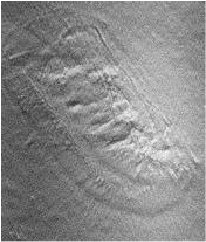 |
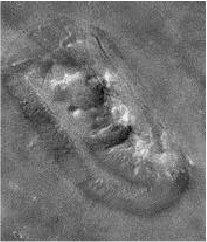 |
| Figure 1. Original JPL contrast enhanced image (left). Extreme high-pass filtering removes tonal variations giving the impression that the "Face" is flat and featureless. Our restored image (right) gives a more accurate representation of the topography and surface detail. | |
How do the images in
Figure 1 compare with the original Viking data? Since the Viking and MGS images were acquired under different lighting conditions and imaging geometries we used a photoclinometrically-derived 3-D elevation model of the "Face" (Carlotto 1988) computed from Viking frame 70A13 to generate simulated perspective views (
Figure 2). The first view predicts the appearance of the "Face" for the April 1998 MGS lighting and imaging conditions. That it is more like our restored MGS image (
Figure 1) suggests our enhancement is a more accurate photometric representation of the "Face" than the one produced by JPL. In the second view in Figure 2, we have projected 70A13 to match the geometry of the new MGS image. Even though the Viking and MGS images are very different in appearance due to the differences in lighting (Viking is directly lit from the upper left and MGS indirectly lit from the bottom right), many points of correspondence are evident.
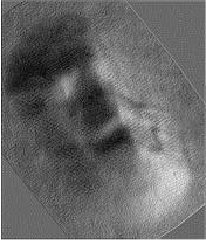 |
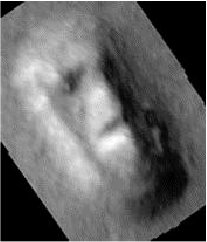 |
| Figure 2 Predicted MGS based on Viking-derived elevation model (left). Viking image reprojected using this model to match MGS view of the "Face" (right). | |
The off-nadir (oblique) MGS imaging geometry distorts the true shape of the "Face" and obscures much of the right (east) side. In an attempt to correct for this distortion, JPL produced a geometrically stretched version of the original image that simulates what the "Face" would look like from above. Orthorectification is a process by which an image that is acquired obliquely is reprojected to appear as if it was taken from directly overhead. However a key point to be made is that only if the terrain is flat can orthorectification be done by simply stretching the image to compensate for the foreshortening in the direction of the observer.
We utilized the Viking derived elevation model used earlier to generate the predictions in
Figure 2 as a terrain model for orthorectifying the Viking and MGS images. Figure 3 (top) shows the orthorectified Viking image of the "Face" next to JPL's geometrical stretch. In their image the internal structure of the object is pushed to the right making it look less symmetrical and face-like. Shown below in
Figure 3 is the Viking image beside our orthorectified MGS image. Vertical lines indicate the approximate left and right edges of the platform (i.e., the base of the "massif") and the lateral center of the object. (We note that because much of the right side is obscured by the central "nose ridge", most pixel values on that side in the orthorectified image have been interpolated. As a result the right side of the image lacks detail. However the lack of detail in the image should not be interpreted to mean that the right side of the object lacks detail as well. A good image showing the right side of the "Face" has yet to be taken.) Measurements derived from orthorectified Viking and MGS images indicate a high degree of lateral symmetry with the left side of the object being about 1.4% wider than the right. Again the similarity between our orthorectified MGS and Viking images suggests these images are a more accurate geometrical representation of the "Face" than JPL's geometric stretch.
 |
 |
 |
 |
| Figure 3 Orthorectified 70A13 (top left) and JPL's geometrically stretched MGS image of the "Face" (top right). Orthorectified 70A13 (bottom left) and MGS image (bottom right) with reference lines drawn to illustrate lateral symmetry. | |
The higher resolution MGS image provides evidence supporting earlier claims (Carlotto 1997) concerning the symmetry of the "Face", the apparent straightness and regularity of the its platform, the presence of linear features on the head above the eyes, and provides new indications concerning the existence of secondary facial characteristics (Figure 4) including nostrils at the end of the nose.
Based on the above observations it is our contention that this "massif" is quite remarkable and is unlike any other in Cydonia.
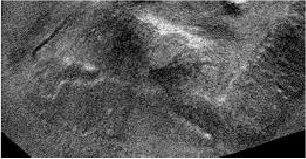 |
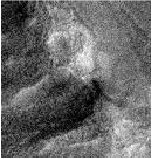 |
| Figure 4 Top view of head showing linear features (left). "Nostrils" and lip-like features (right). If these features are natural why are they located near the lateral centerline of the Face? | |
3. Geological Considerations
It would appear from Pieris paper that Mars anomaly researchers (SPSR in particular) hold only one position on the evolution of Cydonia and that Pieri holds an antithetical position. But in reality, SPSR geologists have, for some time, considered the Cydonia area to display evidence of lacustrine and marine landforms and erosional features (Torun 1993). In fact our studies were prompted, in part, by earlier work co-authored by Pieri (Parker et al, 1993; and Parker et al, 1987). SPSR developed a detailed geomorphic feature map of this area (Erjavec, 1994), on which much subsequent interpretive analysis of Cydonia has been based. That map not only depicts a complex geology in Cydonia, but includes marked evidence for lacustrine, marine and fluviatile processes. The map flatly contradicted the leading thought of that time which stated that Cydonia landforms were primarily the result of differential erosion. Furthermore, MGS images have corroborated the findings of the Cydonia map, showing that this area is the result of many geologic processes with complex interrelationships.
Since 1993, based solely on Viking images at first, publications by SPSR geologists have supported a complex geologic history for Cydonia as well as a lacustrine or marine setting (Erjavec and Nicks 1997, Erjavec, 1997, Erjavec 1998, Moore et al 1999). Pieri states "Such image data suggest a complex formation history, and a complex post-formation depositional and erosional history." It thus appears that there is little disagreement between SPSR and Pieri on this issue. In their analysis of the April 1998 MGS imagery, Erjavec and Brandenburg (1999) come to basically the same conclusions as those voiced by Pieri in his article: strong evidence for marine or lacustrine processes, delineation of the "Face" massif into two structural zones, including a lowermost "shelf-forming" unit, and the suggestion that the layering morphology is indicative of marine sandstones.
A key difference between the two interpretations is that Pieri uses a lack of rilling on the massifs as indication that the primary morphologies were developed in a submarine or lacustrine environment; i.e., the evolution of the "Face" massif occurred underwater. Erjavec and Brandenburg (1999) found what appear to be rills on several Cydonian landforms. This is strong evidence that this area was aerially exposed and erosion occurred through the actions of both precipitation and surface runoff. In combination with the lacustrine or marine signature of this area, it strongly suggests that the morphologies of the Cydonian massifs are polygenetic in origin. This is an important point as it implies that the "Face" was exposed during a time when Mars still had a hydrogeologic cycle. Finally, it should be noted that discussion of the Face massif in terms of general geological characteristics, without reference to the specifically enigmatic details of the object, has no bearing on the question of possible artificiality. It is not inconceivable that in the low gravity of Mars, a large feature may have been artificially modified. The particular structural details of the Face massif that raise questions of origin have yet to be adequately investigated (Crater 1998).
Acknowledgement
The authors wish to thank MSSS and JPL for the use of their imagery.
BIBLIOGRAPHY
Carlotto, Mark J., Digital Imagery Analysis of Unusual Martian Surface Features. Applied Optics, Vol. 27, No. 10 (1988).
Carlotto, Mark J. And Stein, M. C., A Method for Searching for Artificial Objects on Planetary Surfaces. Journal of the British Interplanetary Society, Vol. 43 No. 5 (May, 1990).
Carlotto, Mark J., Evidence in Support of the Hypothesis that Certain Objects on Mars are Artificial in Origin. Journal of Scientific Exploration, Vol. 11, No. 2 (Summer, 1997).
Crater, Horace W. and McDaniel , Mound Configurations on the Cydonia Plain, Journal of Scientific Exploration, Vol. 13, No. 3 (Fall, 1999).
Crater, Horace W. The MGS Cydonia Images: Preliminary Report to NASA (July 1998). (Copy may be down-loaded from http://www.mcdanielreport.com/nasarpt.htm.)
DiPietro and G. Molenaar, Unusual Martian Surface Features, First Edition 1982, Fourth Edition, 1988.
Brandenburg, J.E., DiPietro, V., and Molenaar, G., "The Cydonian hypothesis," Journal of Scientific Exploration, Vol. 5, No. 1 (1991).
Erjavec, J., "Cydonia Geology: Enigmas With An Ocean View?," in The Case for the Face, McDaniel, S. V. and Paxson, M. R. (Eds.), Adventures Unlimited Press, Kempton IL, p. 219-227 (1998).
Erjavec, J., Cydonia: Some Issue, Some Answers?, in Quest for Knowledge Magazine, Top Eventsand Publications Ltd, Chester England, p. 25-27 (1997).
Erjavec, J., Cydonia Region: Geomorphic Feature Map, unpublished map (1994).
Erjavec, J. and Brandenburg, J., "Evidence for a Paleo-Ocean Shoreline, Sedimentary Features and Water Erosion in Cydonia Mensae," AGU Spring Meeting, June 1-4, Boston MA, Abstract, P42A- 10 (1999).
Erjavec, J. and Nicks, R., "Geological Analysis of Enigmatic Landforms in Cydonia," in The Martian Enigmas, A Closer Look, North Atlantic Books, Berkeley CA, p. 67-86 (1997).
McDaniel, S. V. The McDaniel Report. North Atlantic Books (1993).
McDaniel, S. V. and Paxson, M., Eds. The Case for the Face. Adventures Unlimited Press (1998).
Moore, H., Brandenburg, J., Corrick, S., and Sirisena, A., "Ice Found in Crater in Cydonia," AGU Spring Meeting, June 1-4, Boston MA, Abstract, P42A-15 (1999).
O'Leary, Brian., Analysis of Images of the Face on Mars and Possible Intelligent Origin. Journal of the British Interplanetary Society, Vol. 43 No. 5 (May 1990).
Parker, T., Gorsline, D., Saunders, R., Pieri, D. and Schneeberger, D., "Coastal Geomorphology of the Martian Northern Plains," Journal of Geophysical Research, Vol. 98, No. E6, p. 11061-11078 (1993).
Parker, T., Schneeberger, D., Pieri, D., and Saunders, R., "Curvilinear Ridges and Related Features in Southwest Cydonia Mensae, Mars," Reports of the Planetary Geology Program, NASA TM 89810, pp. 502-504 (1987).
Pozos, Randolfo R., Ed. The Face on Mars. Chicago Review Press (1986).
Sagan, Carl The Demon-Haunted World: Science as a Candle in the Dark. Random House, NY, pg. 53 (1995).
Torun, E., Personal communication (1993).
Please address correspondence to: spsr@utsi.edu